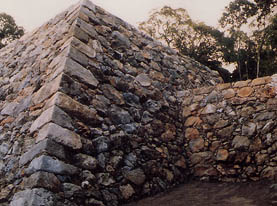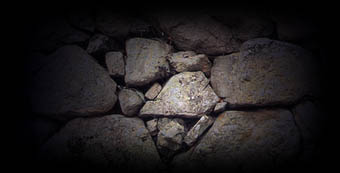Characteristics of Anoushu stone stacking
| The secret of the robustness of the walls is inside the stone. |  Iwakuni castle (Iwakun) | |
|---|---|---|
| One can separate the stone stacking methods into three categories; nozura-zumi ("weathered stone" stacking. There is minimal fabrication of the stone used in the wall), uchikomi-hagi (more work is put to each stone, resulting in a tighter fit), and kirikomi-hagi (each stone is meticulously worked and the result is perfect fitting stone wall). The Anoushu stone stacking is representative of the nozura-zumi. It might look crude at first glance, but its robustness is unparalleled. Its secret lays in where the weight of the stone rest. The weight of the stone is designed to rest about 1/3 of the depth from the surface of the stone wall and also, to prevent water damage, there is a layer of large gravel (fist sized) before the smaller gravel, this helps with the drainage of the water. It is in these out of sight parts that the secret handed down to Anoushu resides, and that in turn gives the robustness for a wall to stand the elements for centuries. | ||

| To hear the voice of the stone and to be guided by stone is our job. | |
| We go to the stone pile and, for a day or two, walk around and around the stones, committing to memory each stone's personality. Then, drawing a mental image, we start placing the stones in our head. So, by the time the real stone stacking starts, there is already a complete blueprint in our minds. It will be more accurate to say that we converse and listen to the stone, rather than just telling them apart. As you work with the stone for a long period of time, it starts to teach you. The Anoushu skills were all handed down verbally, but, that is not because it is a mystery, but rather because it cannot be expressed in letters. | ||